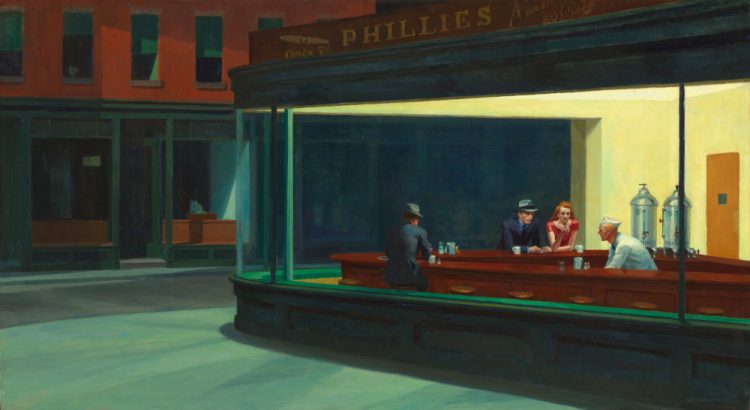
Edward Hopper artworks are a series of evocative portrayals of solitude, urban landscapes, and the American experience.
Precisely drawn, with clean lines, subdued colours and mute characters, his artwork quietly screams of the loneliness of city living.
In a series of barren bedsits, diners, and other desolate settings, Hopper conjures up a sense of the automaton; people going through the motions, carrying an innate sadness deep inside them.
Hopper is one of the most prominent American realist painters of the 20th century. He created an indelible mark on the art world with his starched portrayals of the superficiality of the human condition.
Born on July 22, 1882, in Nyack, New York, Hopper’s meticulous attention to light and shadow, along with his stark and often somber compositions, conveys a poignant narrative of modern life.

Famous Artworks
Hopper’s most renowned piece, “Nighthawks” (1942), is an iconic image that captures the essence of urban isolation. Set in a late-night diner, the painting features three customers and a server, each absorbed in their own world, under the harsh, artificial light of the establishment. The scene, devoid of external context and bathed in a moody stillness, reflects a moment of eerie quietness in the heart of a bustling city. Hopper described his intent behind “Nighthawks” as capturing “the loneliness of a large city.”
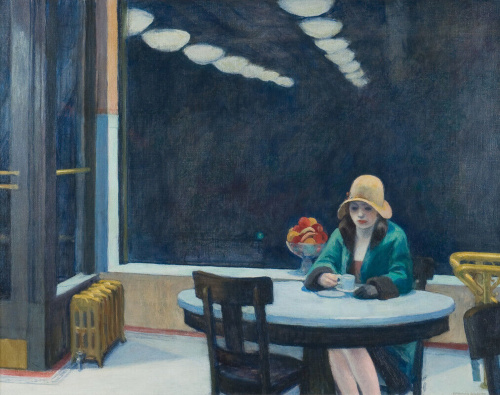
Another notable of Edward Hopper Artworks is “Automat” (1927), it depicts a solitary woman in an automat restaurant, staring into a cup of coffee. The empty chair opposite her and the reflective mirror amplify the sense of isolation. The reflection of the Automat ceiling lights in the window piercing the gloom, is quintessential Hopper, creating a juxtaposition between the inner and outer worlds.
“House by the Railroad” (1925) is another masterpiece that highlights Hopper’s fascination with architecture and desolation. The painting inspired the look of the Bates house in Alfred Hitchcock’s “Psycho.” The stark, Victorian house stands solitary against the horizon, embodying a quiet, melancholic presence.
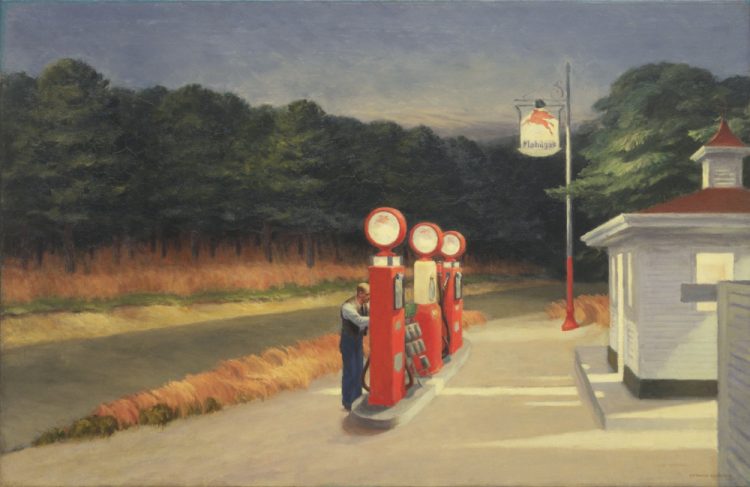

Influences
Hopper’s early training at the New York School of Art under the tutelage of William Merritt Chase, Robert Henri, and Kenneth Hayes Miller profoundly influenced his artistic direction. Henri, in particular, encouraged Hopper to focus on modern life, pushing him towards realism and the depiction of contemporary urban scenes.
European artists also significantly influenced Hopper. His trips to Paris between 1906 and 1910 exposed him to the works of the Impressionists and Post-Impressionists. He admired Edgar Degas’ use of light and shadow and was particularly struck by Edouard Manet’s urban scenes and Gustave Caillebotte’s compositions, which reflected modern life’s isolation.
Despite these influences, Hopper carved out a unique niche for himself. He once stated, “I was more interested in the sunlight on the buildings and on the figures than in any symbolism.” This focus on light and its interaction with the environment became a hallmark of his work.
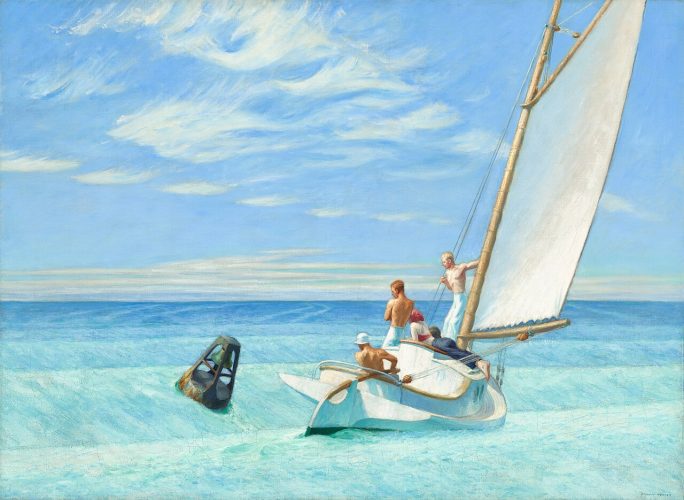
Themes and Techniques
Hopper’s art is characteriSed by a meticulous composition and a unique interplay of light and shadow. His works often feature solitary figures in urban or semi-rural settings, highlighting themes of isolation, introspection, and the mundane aspects of everyday life. His architectural structures, whether urban diners or solitary lighthouses, are rendered with precise geometric clarity, contributing to the overall mood of his paintings.
The interplay of light and shadow in Hopper’s work is both literal and metaphorical. The way light filters through windows, reflects off surfaces and casts shadows plays a crucial role in creating the mood and narrative of his scenes. Hopper’s use of light has been described as “the light that never was,” an artificial and almost haunting illumination that heightens the emotional impact of his work.

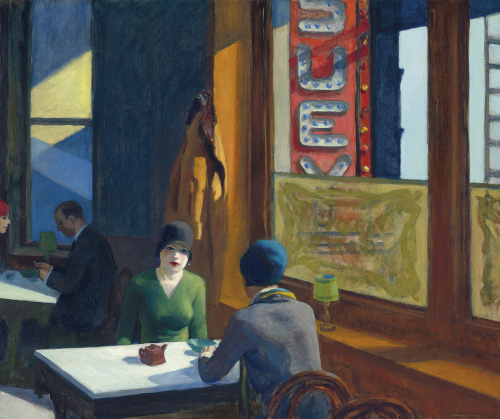
Quotes from Hopper and Contemporaries
Hopper’s contemporaries and critics often noted the unique emotional resonance of his work. Art critic Clement Greenberg observed, “Hopper is simply a bad painter. But if he had been a better painter, he would probably not have been such a great artist.” This paradoxical statement highlights the idea that Hopper’s technical imperfections were overshadowed by his ability to evoke deep emotional responses.
Hopper himself was reticent about his work’s deeper meanings, preferring viewers to interpret them personally. He remarked, “The whole answer is there on the canvas.” This emphasis on personal interpretation contributes to the timeless and universal appeal of his art.
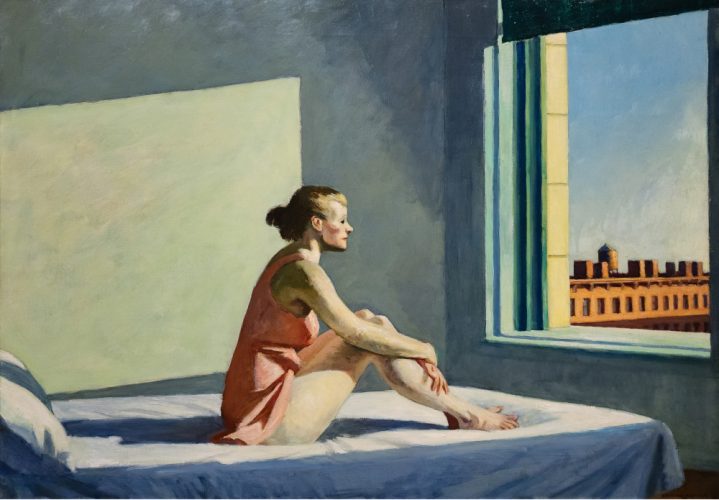
Legacy
Edward Hopper artworks’ influence extends far beyond the realm of painting. His cinematic compositions and moody atmospheres have inspired filmmakers, photographers, and writers. Alfred Hitchcock, for example, drew inspiration from Hopper’s works, particularly “House by the Railroad,” for the eerie ambience of “Psycho.”
Hopper’s work remains a poignant exploration of the human condition, capturing moments of quiet introspection and solitude amidst the bustling backdrop of modern life. His paintings are a testament to the power of realism to convey complex emotional narratives, making him a cornerstone of American art.
Edward Hopper’s legacy lies in his unparalleled ability to distil the essence of American life into his paintings. Through his masterful use of light and shadow, precise compositions, and exploration of desolation and human isolation, Hopper’s work continues to resonate, offering a profound, contemplative view of the modern world.
Further Reading
Edward Hopper: A Fresh Look at Landscape by Riehen / Basel Fondation Beyeler – BUY IT HERE
Edward Hopper’s New York – by Kim Conaty – BUY IT HERE
Edward Hopper: A-Z – by Ulf Küster – BUY IT HERE
Edward Hopper: Forty Masterworks – by Heinz Liesbrock and Edward Hopper – BUY IT HERE
